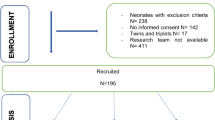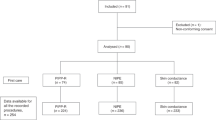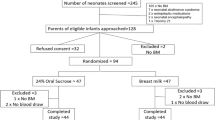Abstract
Objective
To compare skin-to-skin care (SSC) and oral sucrose for preterm neonatal pain control.
Methods
Preterm neonates (28–36 weeks gestation) requiring heel-stick were eligible. In group-A, SSC was given 15-min before first heel-stick, and sucrose was given 2-min before second heel-stick. In group-B, the sequence was reversed. Blinded premature infant pain profile (PIPP) score assessment was done at 0, 1, and 5-min of heel-stick by two assessors.
Results
A hundred neonates were enrolled. The inter-rater agreement for the PIPP score was good. The behavior state component was significantly lower in the sucrose group at all assessment points. The mean (SD) difference between 1-min and 0 min was similar [SSC 3.58(3.16) vs. sucrose 4.09(3.82), p = 0.24] between groups. The PIPP score attained baseline values at 5-min in both groups.
Conclusion
Albeit sucrose indicated instantaneous action, SSC and sucrose have comparable clinical efficacy for preterm neonatal pain control. Multisensory stimulation with SSC may result in a higher behavioral state component of the PIPP score.
This is a preview of subscription content, access via your institution
Access options
Subscribe to this journal
Receive 12 print issues and online access
$259.00 per year
only $21.58 per issue
Buy this article
- Purchase on Springer Link
- Instant access to full article PDF
Prices may be subject to local taxes which are calculated during checkout


Similar content being viewed by others
References
Vinall J, Grunau RE. Impact of repeated procedural pain-related stress in infants born very preterm. Pediatr Res. 2014;75:584–7.
Anand KJ, Scalzo FM. Can adverse neonatal experiences alter brain development and subsequent behavior? Biol Neonate. 2000;77:69–82.
Mangat AK, Oei JL, Chen K, Quah-Smith I, Schmölzer GM. A review of non-pharmacological treatments for pain management in newborn infants. Children. 2018;5:130.
Stevens B, Yamada J, Ohlsson A. Sucrose for analgesia in newborn infants undergoing painful procedures. Cochrane Database Syst Rev. 2010;1:CD001069.
Johnston CC, Filion F, Snider L, Majnemer A, Limperopoulos C, Walker CD, et al. Routine sucrose analgesia during the first week of life in neonates younger than 31 weeks’ postconceptional age. Pediatrics 2002;110:523–8.
Shukla V, Chapla A, Uperiya J, Nimbalkar A, Phatak A, Nimbalkar S. Sucrose vs. skin to skin care for preterm neonatal pain control-a randomized control trial. J Perinatol. 2018;38:1365–9.
Johnston C, Campbell-Yeo M, Fernandes A, Inglis D, Streiner D, Zee R. Skin-to-skin care for procedural pain in neonates. Cochrane Database Syst Rev. 2014;1:CD008435.
Campbell-Yeo M, Johnston C, Benoit B, Latimer M, Vincer M, Walker CD, et al. Trial of repeated analgesia with Kangaroo Mother Care (TRAKC Trial). BMC Pediatr. 2013;13:182.
Mitchell AJ, Yates CC, Williams DK, Chang JY, Hall RW. Does daily kangaroo care provide sustained pain and stress relief in preterm infants? J Neonatal Perinat Med. 2013;6:45–52.
Kostandy R, Anderson GC, Good M. Skin-to-skin contact diminishes pain from hepatitis B vaccine injection in healthy full-term neonates. Neonatal Netw. 2013;32:274–80.
Nimbalkar SM, Chaudhary NS, Gadhavi KV, Phatak A. Kangaroo Mother Care in reducing pain in preterm neonates on heel prick. Indian J Pediatr. 2013;80:6–10.
Potana NT, Dongara AR, Nimbalkar SM, Patel DV, Nimbalkar AS, Phatak A. Oral sucrose for pain in neonates during echocardiography: a randomized controlled trial. Indian Pediatr. 2015;52:493–7.
Nimbalkar AS, Dongara AR, Phatak AG, Nimbalkar SM. Knowledge and attitudes regarding neonatal pain among nursing staff of pediatric department: an Indian experience. Pain Manag Nurs. 2014;15:69–75.
Shukla VV, Bansal S, Nimbalkar A, Chapla A, Phatak A, Patel D, et al. Pain control interventions in preterm neonates: a randomized controlled trial. Indian Pediatr. 2018;55:292–6.
Nimbalkar S, Sinojia A, Dongara A. Reduction of neonatal pain following administration of 25% lingual dextrose: a randomized control trial. J Trop Pediatr. 2013;59:223–5.
Sarnat HB, Sarnat MS. Neonatal encephalopathy following fetal distress. A clinical and electroencephalographic study. Arch Neurol. 1976;33:696–705.
Papile LA, Munsick-Bruno G, Schaefer A. Relationship of cerebral intraventricular hemorrhage and early childhood neurologic handicaps. J Pediatr. 1983;103:273–7.
Stevens B, Johnston C, Petryshen P, Taddio A. Premature infant pain profile: development and initial validation. Clin J Pain. 1996;12:13–22.
Stevens B, Yamada J, Campbell-Yeo M, Gibbins S, Harrison D, Dionne K, et al. The minimally effective dose of sucrose for procedural pain relief in neonates: a randomized controlled trial. BMC Pediatr. 2018;18:85.
Tsao JC, Evans S, Meldrum M, Altman T, Zeltzer LK. A review of CAM for procedural pain in infancy: part I. Sucrose and non-nutritive sucking. Evid Based Complement Altern Med. 2008;5:371–81.
Stevens B, Yamada J, Ohlsson A, Haliburton S, Shorkey A. Sucrose for analgesia in newborn infants undergoing painful procedures. Cochrane Database Syst Rev. 2016;7:CD001069.
Gao H, Gao H, Xu G, Li M, Du S, Li F, et al. Efficacy and safety of repeated oral sucrose for repeated procedural pain in neonates: a systematic review. Int J Nurs Stud. 2016;62:118–25.
McCall JM, DeCristofaro C, Elliott L. Oral sucrose for pain control in nonneonate infants during minor painful procedures. J Am Assoc Nurse Pract. 2013;25:244–52.
Johnston C, Campbell-Yeo M, Disher T, Benoit B, Fernandes A, Streiner D, et al. Skin-to-skin care for procedural pain in neonates. Cochrane Database Syst Rev. 2017;2:CD008435.
Slater R, Cornelissen L, Fabrizi L, Patten D, Yoxen J, Worley A, et al. Oral sucrose as an analgesic drug for procedural pain in newborn infants: a randomised controlled trial. Lancet. 2010;376:1225–32.
Holsti L, Grunau RE. Considerations for using sucrose to reduce procedural pain in preterm infants. Pediatrics. 2010;125:1042–7.
Korner AF, Kraemer HC, Reade EP, Forrest T, Dimiceli S, Thom VA. A methodological approach to developing an assessment procedure for testing the neurobehavioral maturity of preterm infants. Child Dev. 1987;58:1478–87.
Johnston CC, Filion F, Campbell-Yeo M, Goulet C, Bell L, McNaughton K, et al. Kangaroo mother care diminishes pain from heel lance in very preterm neonates: a crossover trial. BMC Pediatr. 2008;8:13.
Quirion R. Pain, nociception and spinal opioid receptors. Prog Neuropsychopharmacol Biol Psychiatry. 1984;8:571–9.
Matthiesen AS, Ransjö-Arvidson AB, Nissen E, Uvnäs-Moberg K. Postpartum maternal oxytocin release by newborns: effects of infant hand massage and sucking. Birth. 2001;28:13–9.
Nelson EE, Panksepp J. Brain substrates of infant-mother attachment: contributions of opioids, oxytocin, and norepinephrine. Neurosci Biobehav Rev. 1998;22:437–52.
Nimbalkar SM, Patel VK, Patel DV, Nimbalkar AS, Sethi A, Phatak A. Effect of early skin-to-skin contact following normal delivery on incidence of hypothermia in neonates more than 1800 g: randomized control trial. J Perinatol. 2014;34:364–8.
Bystrova K, Widström AM, Matthiesen AS, Ransjö-Arvidson AB, Welles-Nyström B, Wassberg C, et al. Skin-to-skin contact may reduce negative consequences of “the stress of being born”: a study on temperature in newborn infants, subjected to different ward routines in St. Petersburg. Acta Paediatr. 2003;92:320–6.
Safari K, Saeed AA, Hasan SS, Moghaddam-Banaem L. The effect of mother and newborn early skin-to-skin contact on initiation of breastfeeding, newborn temperature and duration of third stage of labor. Int Breastfeed J. 2018;13:32.
Moore ER, Anderson GC, Bergman N, Dowswell T. Early skin-to-skin contact for mothers and their healthy newborn infants. Cochrane Database Syst Rev. 2012;5:CD003519.
Moore ER, Bergman N, Anderson GC, Medley N. Early skin-to-skin contact for mothers and their healthy newborn infants. Cochrane Database Syst Rev. 2016;11:CD003519.
Aghdas K, Talat K, Sepideh B. Effect of immediate and continuous mother-infant skin-to-skin contact on breastfeeding self-efficacy of primiparous women: a randomised control trial. Women Birth. 2014;27:37–40.
Sharma A. Efficacy of early skin-to-skin contact on the rate of exclusive breastfeeding in term neonates: a randomized controlled trial. Afr Health Sci. 2016;16:790–7.
Stevens J, Schmied V, Burns E, Dahlen H. Immediate or early skin-to-skin contact after a Caesarean section: a review of the literature. Matern Child Nutr. 2014;10:456–73.
Lawn JE, Mwansa-Kambafwile J, Horta BL, Barros FC, Cousens S. ‘Kangaroo mother care’ to prevent neonatal deaths due to preterm birth complications. Int J Epidemiol. 2010;39 Suppl 1:i144–54.
Conde-Agudelo A, Belizán JM, Diaz-Rossello J. Kangaroo mother care to reduce morbidity and mortality in low birthweight infants. Cochrane Database Syst Rev. 2011;3:CD002771.
Evereklian M, Posmontier B. The impact of kangaroo care on premature infant weight gain. J Pediatr Nurs. 2017;34:e10–6.
Boundy EO, Dastjerdi R, Spiegelman D, Fawzi WW, Missmer SA, Lieberman E, et al. Kangaroo mother care and neonatal outcomes: a meta-analysis. Pediatrics. 2016;137:e20152238.
Author information
Authors and Affiliations
Contributions
SN conceptualized and designed the study, coordinated and supervised the analysis, and substantially reviewed and revised the manuscript. VVS conceptualized and designed the study, coordinated data collection, drafted the initial manuscript and reviewed and revised the manuscript. VC conceptualized and designed the study, undertook data collection, and reviewed and revised the manuscript. AP designed the study, conducted the analysis and reviewed the manuscript for important intellectual content. DP contributed to the data collection, reviewed and revised the manuscript. AC designed the study, and reviewed and revised the manuscript. AN designed the study, coordinated and supervised data collection, and reviewed the manuscript. All authors approved the final manuscript as submitted and agree to be accountable for all aspects of the work.
Corresponding author
Ethics declarations
Conflict of interest
The authors declare that they have no conflict of interest.
Additional information
Publisher’s note Springer Nature remains neutral with regard to jurisdictional claims in published maps and institutional affiliations.
Rights and permissions
About this article
Cite this article
Nimbalkar, S., Shukla, V., Chauhan, V. et al. Blinded randomized crossover trial: Skin-to-skin care vs. sucrose for preterm neonatal pain. J Perinatol 40, 896–901 (2020). https://doi.org/10.1038/s41372-020-0638-9
Received:
Revised:
Accepted:
Published:
Issue Date:
DOI: https://doi.org/10.1038/s41372-020-0638-9



